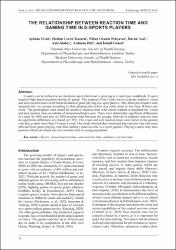The Relationship Between Reaction Time And Gaming Time in E-Sports Players

View/
Access
info:eu-repo/semantics/openAccessDate
2022Author
Ersin, AybükeTezeren, Halime Ceren
Pekyavaş, Nihan Özünlü
Asal, Burak
Atabey, Anıl
Diri, Ardacan
Gönen, İsmail
Metadata
Show full item recordCitation
Ersin, A., Tezeren, H. C., Ozunlu Pekyavas, N., Asal, B., Atabey, A., Diri, A., & Gonen, İ. (03.04.2022). The Relationship Between Reaction Time And Gaming Time in E-Sports Players. Kinesiology, 54(1). pp. 36–42. https://doi.org/10.26582/k.54.1.4 Abstract
E-sports can be defined as an electronic sports form and is growing at a rapid pace worldwide. E-sport
requires high-speed reactions during all games. The purpose of this study was to evaluate auditory, visual
and aim reaction times of different duration of game playing in e-sport players. Fifty-three participants were
assigned into two groups according to their playing time which was either more or less than 14 hours per
week. The participants were tested for auditory reaction time with online website at playback.fm, visual
and aim reaction time on website of humanbenchmark.com. There were statistically significant differences
in visual (p<.001) and aim (p<.001) reaction time between the groups, whereas in auditory reaction time
no significant difference was found (p=.397). The visual and aim reaction times were better in the gamers
who play e-sport more than 14 hours a week. Our study showed that visual and aim reaction time was more
affected from game playing time than auditory reaction time in e-sport gamers. Playing e-sport may have
positive effects on visual and aim reaction time in young population.
















